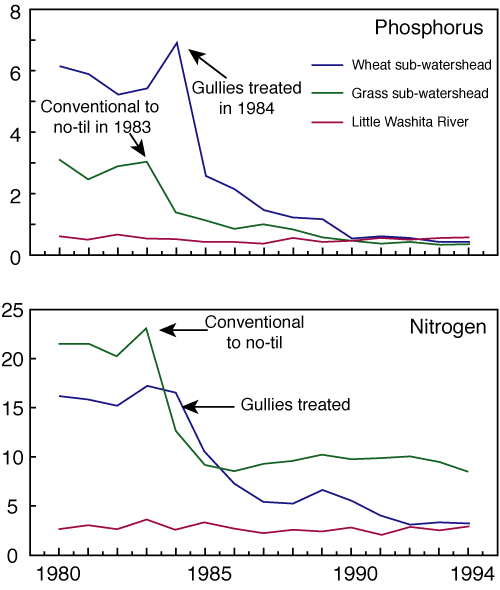


 |  |  | 17.6 Remediation of cultural eutrophication |
An obvious mode to reduce the effects of cultural eutrophication is reduction of resource use in the drainage area. This could be achieved by a reduction of fertilisers use and limitations of husbandry. An obvious step would be to reduce nutrient discharge to the aquifer. This implies that steps are taken that effluents from fields, intensive husbandry towns and factories are strongly regulated. By regulating gullies and tiles in agricultural regions significant declines of nutrient discharge can be achieved (Figure 8; see Agriculture Chapter). With regard to point sources removal of nutrients by additional sewage plants could be an option. Low-price biological removal plants should be considered. Harvesting weeds in ponds and bringing them back to the fields or include them into compost is an option that is not adequately considered.
In marine environments growing blue mussels in river mouths can reduce eutrophication. By removing the rapidly growing mussels and transport them into the aquifer (compost, waste disposal sites etc.) the nutrient residence time can be significantly be increased. This is an efficient and low-cost manner to decrease the discharge of nutrients into coastal regions. One can also decrease the direct discharge of effluents to small rivers and streams by planting bushes and trees, which in recent decades have been removed by agricultural means to increase the farm area. To collect water from ditches that drain the tillage from fields into dams, is another manner to decrease direct and rapid losses of nutrients from agriculture (e.g. Figure 8). Taking fields out of production and destroying tillage is still another option that should be considered in times when overproduction of food is a predominant characteristic of agriculture in Europe.

A natural manner to get rid of nitrogen is denitrification. How can we increase denitrification in a drainage area? Denitrification is highest in waterlogged soils that are not efficient for agriculture. The height of water in ditches, the presence of dams and the amount of wetlands are important aspects of increasing denitrification. In many cases converting fields into wetland implies transferring them back into their original state. Often wetlands and waterlogged soils have been converted into farmlands previously. Wetland restoration is by far the most efficient and cheapest manner to reduce nitrogen supply to rivers and coastal zones, with ramifications for biodiversity and ecosystem variety.
The increasing imbalance between nutrients is of major concern. While nothing can be done with the decreasing discharge of Si unless dams are removed, the balance of the N and P discharge could be improved. So far the major goal has been to reduce nutrient discharge per se. While this is a first, important step, the next must be to figure out if the discharge of N and P could be closer to the Redfield ratio to achieve a more environmental friendly composition.
The basic goal for reducing the eutrophication in streams, lakes and coastal waters is fist of all to increase their residence time on land and omit the present short-circuits in the nutrient cycles. This would decrease fertilizer use and result in a higher net-utilization of nutrients by man. Returning marine biomass back to the drainage area and spreading human and animal excrements efficiently in the drainage area is an option that has been previously applied and should be reconsidered. Decreased meat consumption (Figure 8) or more spread meat production are additional options that would decrease nutrient discharge.
 |  |  | 17.6 Remediation of cultural eutrophication |